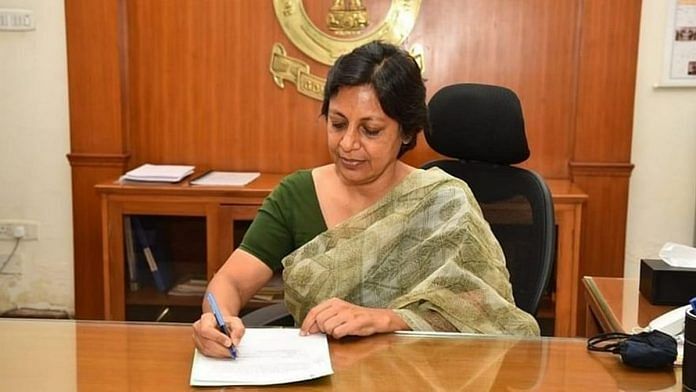New Delhi: With assurance from the central government that there will be no dearth of funds for its flagship ‘Har Ghar Jal’ scheme, the Jal Shakti ministry is pushing states to step up their infrastructure to provide a functional tap water connection to every rural household by end-2024, Vini Mahajan, secretary, department of drinking water and sanitation (DDWS), told ThePrint in an interview.
Former Punjab chief secretary Mahajan was appointed secretary in the DDWS, which is piloting the drinking water scheme, a month ago (December 2021).
“The Centre has told us that there is no dearth of funds for a high priority scheme like Nal Se Jal. We are expecting around Rs 45,000-50,000 crore for the scheme in the 2022-23 budget. A similar allocation was made in the 2021-22 fiscal also, which has been almost utilised,” Mahajan said.
Besides the budgetary allocation, the 15th Finance Commission has tied grants of Rs 1.42 lakh crore to gram panchayats to provide tap water connection and sanitation facilities in villages from 2021-22 to 2025-26.
Of the Rs 3.6 lakh crore earmarked for the ‘Nal Se Jal’ scheme for five years starting 2019, 50 per cent will be the central government’s share, while the states will bear the remaining 50 per cent. For union territories, the central government will provide 100 per cent funding.
“As the scheme is picking up pace, the states’ appetite for utilising the budget is also showing an uptick. The states are recognising the felt need of rural households who still do not have tap water inside their houses. Besides, the scheme also positively impacts the health of the rural population,” Mahajan said.
Also Read: In rural Punjab, Nal Se Jal has brought not just water but also a luxury few had: ‘free time’
‘Rural households willing to pay for water’
The aim of the scheme is to provide potable drinking water through individual tap connections in all households in rural India.
In 2019, only 3.23 crore (17 per cent) of 19.22 crore rural households had tap water connections, according to government data. The ministry’s target was to cover the remaining 16 crore (83 per cent) households by 2024.
Since ‘Nal Se Jal’ was launched in August 2019, around 8.8 crore households have been provided functional tap connections, ministry figures show. While the states of Haryana, Goa and Telangana, and union territories Andaman and Nicobar Islands, Puducherry, Daman and Diu and Dadra and Nagar Haveli, have achieved 100 per cent tap water connections in households, a total of 96 districts across the country have 100 per cent tap water connections under the scheme.
The scheme is based on a unique model where paani samitis (water committee) comprising villagers will decide what they will pay for the water they consume. The tariff they fix will not be the same for everyone in the village. Those who have large households will pay more, while poor households or households where there is no earning member, will be exempted, Mahajan said.
With more and more districts getting 100 per cent tap water connections, the next step of collecting water charges has also started in many villages, the DDWS secretary further said.
“The good thing is that as more and more homes are getting connected to tap water connections and getting regular water, there is a willingness to pay. It’s still a work in progress,” she added.
Third-party audits for water quality
Mahajan said the main challenge is undertaking such a large scheme in a time-bound manner. “But the good thing is that states such as Uttar Pradesh, West Bengal, Odisha, Chhattisgarh, which started from a low base, are now gaining ground. The states are very positive in their approach,” she added.
Though the Covid-19 pandemic affected work to some extent, Mahajan said she is optimistic of achieving the target of providing functional tap water connection in every rural household by the end of 2024.
“We are now providing around 60,000 new tap water connections a day. Our target is to ramp it up to 1 lakh new connections a day,” the DDWS secretary said.
Mahajan further said that alongside providing new tap water connections, the department is also undertaking a third party audit to check the quality of work that is being done, whether the water flow is regular and at the right pressure, etc. “The third party audit will start concurrently at periodic intervals. It will help us address any gaps or deficiencies,” she added.
To monitor the quality of drinking water being supplied to households, the Jal Shakti ministry has put in place comprehensive guidelines that mandate setting up of government-accredited laboratories across states, districts and blocks in the next year.
All laboratories will have to be accredited by the National Accreditation Board for Testing and Calibration Laboratories, and will also allow the public to get water samples tested to ascertain if they adhere to the prescribed quality.
(Edited by Gitanjali Das)
Also Read: 32% backward districts, 30% encephalitis-hit districts now have tap water under Nal Se Jal



